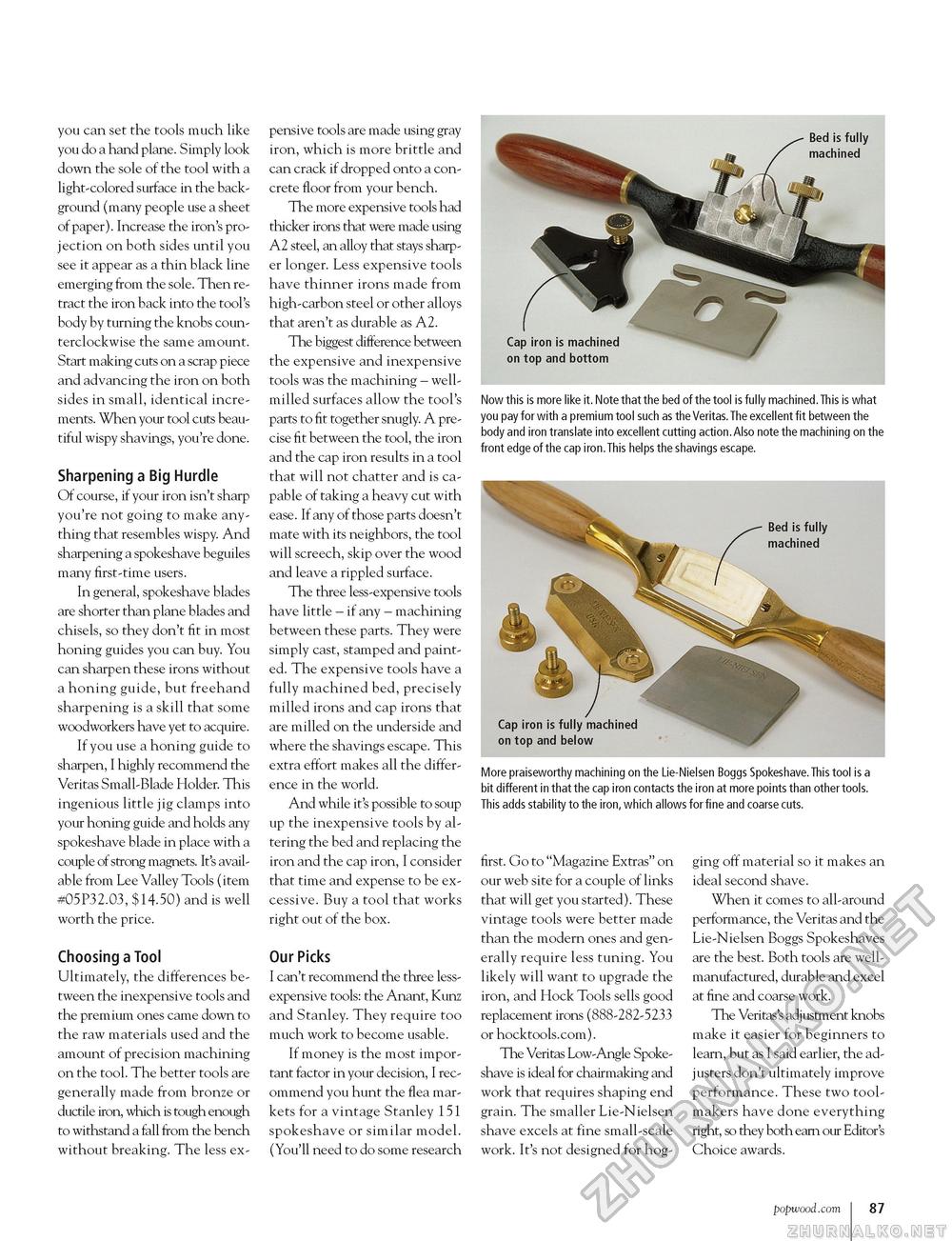Popular Woodworking 2004-04 № 140, страница 90
Now this is more like it. Note that the bed of the tool is fully machined. This is what you pay for with a premium tool such as the Veritas.The excellent fit between the body and iron translate into excellent cutting action.Also note the machining on the front edge of the cap iron.This helps the shavings escape. More praiseworthy machining on the Lie-Nielsen Boggs Spokeshave.This tool is a bit different in that the cap iron contacts the iron at more points than other tools. This adds stability to the iron, which allows for fine and coarse cuts. you can set the tools much like you do a hand plane. Simply look down the sole of the tool with a light-colored surface in the background (many people use a sheet of paper). Increase the iron's projection on both sides until you see it appear as a thin black line emerging from the sole. Then retract the iron back into the tool's body by turning the knobs counterclockwise the same amount. Start making cuts on a scrap piece and advancing the iron on both sides in small, identical increments. When your tool cuts beautiful wispy shavings, you're done. Sharpening a Big Hurdle Of course, if your iron isn't sharp you're not going to make anything that resembles wispy. And sharpening a spokeshave beguiles many first-time users. In general, spokeshave blades are shorter than plane blades and chisels, so they don't fit in most honing guides you can buy. You can sharpen these irons without a honing guide, but freehand sharpening is a skill that some woodworkers have yet to acquire. If you use a honing guide to sharpen, I highly recommend the Veritas Small-Blade Holder. This ingenious little jig clamps into your honing guide and holds any spokeshave blade in place with a couple of strong magnets. It's available from Lee Valley Tools (item #05P32.03, $14.50) and is well worth the price. Choosing a Tool Ultimately, the differences between the inexpensive tools and the premium ones came down to the raw materials used and the amount of precision machining on the tool. The better tools are generally made from bronze or ductile iron, which is tough enough to withstand a fall from the bench without breaking. The less ex pensive tools are made using gray iron, which is more brittle and can crack if dropped onto a concrete floor from your bench. The more expensive tools had thicker irons that were made using A2 steel, an alloy that stays sharper longer. Less expensive tools have thinner irons made from high-carbon steel or other alloys that aren't as durable as A2. The biggest difference between the expensive and inexpensive tools was the machining - well-milled surfaces allow the tool's parts to fit together snugly. A precise fit between the tool, the iron and the cap iron results in a tool that will not chatter and is capable of taking a heavy cut with ease. If any of those parts doesn't mate with its neighbors, the tool will screech, skip over the wood and leave a rippled surface. The three less-expensive tools have little - if any - machining between these parts. They were simply cast, stamped and painted. The expensive tools have a fully machined bed, precisely milled irons and cap irons that are milled on the underside and where the shavings escape. This extra effort makes all the difference in the world. And while it's possible to soup up the inexpensive tools by altering the bed and replacing the iron and the cap iron, I consider that time and expense to be excessive. Buy a tool that works right out of the box. Our Picks I can't recommend the three less-expensive tools: the Anant, Kunz and Stanley. They require too much work to become usable. If money is the most important factor in your decision, I recommend you hunt the flea markets for a vintage Stanley 151 spokeshave or similar model. (You'll need to do some research first. Go to "Magazine Extras" on our web site for a couple of links that will get you started). These vintage tools were better made than the modern ones and generally require less tuning. You likely will want to upgrade the iron, and Hock Tools sells good replacement irons (888-282-5233 or hocktools.com). The Veritas Low-Angle Spoke-shave is ideal for chairmaking and work that requires shaping end grain. The smaller Lie-Nielsen shave excels at fine small-scale work. It's not designed for hog ging off material so it makes an ideal second shave. When it comes to all-around performance, the Veritas and the Lie-Nielsen Boggs Spokeshaves are the best. Both tools are well-manufactured, durable and excel at fine and coarse work. The Veritas's adjustment knobs make it easier for beginners to learn, but as I said earlier, the adjusters don't ultimately improve performance. These two tool-makers have done everything right, so they both earn our Editor's Choice awards. popwood.com 87 |








